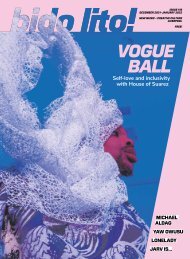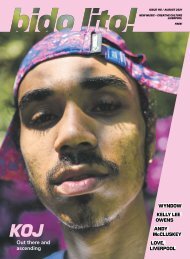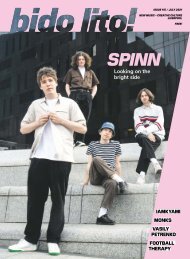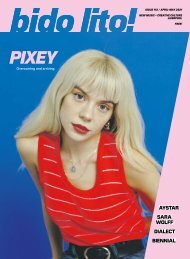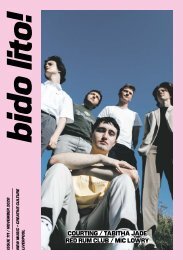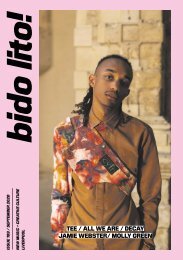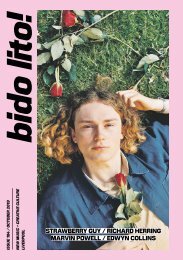Bido Lito June 2021 Issue 114
June 2021 issue of Bido Lito! magazine. Featuring: PODGE, THE CORAL, CRAWLERS, RON'S PLACE, KATY J PEARSON, SEAGOTH, MONDO TRASHO, LIVERPOOL BIENNIAL AND MUCH MORE.
June 2021 issue of Bido Lito! magazine. Featuring: PODGE, THE CORAL, CRAWLERS, RON'S PLACE, KATY J PEARSON, SEAGOTH, MONDO TRASHO, LIVERPOOL BIENNIAL AND MUCH MORE.
You also want an ePaper? Increase the reach of your titles
YUMPU automatically turns print PDFs into web optimized ePapers that Google loves.
therefore they stagnate the art scene,” Knox explains,<br />
restricting affordability, accessibility and creative freedom.<br />
Artists need space, either for temporary exhibitions and<br />
performances, or as studio space and “the more central<br />
spaces can be, the more visible independent artists can<br />
be”, Patrick Kirk-Smith emphasises, allowing them to be<br />
seen and heard. However, as Liverpool has developed and<br />
become more attractive, artists are increasingly unable to<br />
access affordable city centre spaces, or are exploited as<br />
temporary solutions to reviving vacant or disused buildings<br />
before being “systematically forced out”. “Everything is<br />
monetised now,” Knox laments. “Buildings are bought and<br />
they’re sat on… A lot of the buildings that were potentially<br />
useful and could have been for artists to go into are no<br />
longer available, because people see them as potential to<br />
make money. They can’t see the bigger picture.”<br />
During its history, Road Studios has faced two<br />
evictions, a High Court ruling and constant uncertainty in<br />
the fight to retain its city centre location on Victoria Street.<br />
“[The property owners] systematically moved the goal<br />
posts by taking away access to the building, it was literally<br />
a building site… It got to the point where they actually<br />
smashed the toilets as tenants were still in the building.”<br />
Sadly, in 2019, Road was evicted and forced out of the<br />
city centre, securing a space in the Baltic’s Northern Lights<br />
building. Knox believes that property developers “play the<br />
white knight”, purporting to support artist studios and<br />
provide them with space, only to abandon them once a<br />
more profitable option surfaces. The experience of Road<br />
Studios encapsulates the situation facing artist studios<br />
across the city and the hostile environment they face.<br />
Artists recognise and champion their ability to<br />
“add value to space” and “enrich communities”, as Faye<br />
Hamblett-Jones explains, reviving the communities they<br />
exist within. “Artist studios anchor creative people, art<br />
and cultural activity in their neighbourhood,” as a report<br />
from the National Federation of Artists’ Studios Providers<br />
from 2014 indicates. In addition to providing local<br />
amenities in the forms of cafés, workspaces and events or<br />
workshops, the presence of artist studios creates a sense<br />
of ‘something happening’, piercing through the stagnancy<br />
that often dominates forgotten communities. “Artists<br />
have [always] been used as a catalyst for regeneration,”<br />
Knox acknowledges; however, artist studios want to be<br />
seen as a permanent part of the city’s infrastructure, not<br />
simply used to develop an area before being outpriced,<br />
abandoned and marginalised.<br />
Liverpool is a city that understands more than most<br />
the power of culture to stimulate regeneration and<br />
transform city landscapes. In recent years, invigorated by<br />
the success of 2008, Liverpool has positioned culture as<br />
a primary driver of revival and growth, defining itself as a<br />
‘creative city’. This has transformed external perceptions,<br />
reflected in the development of the tourism and leisure<br />
industry, which was worth £4.9 billion in 2018. The<br />
continuing relevance of this approach is epitomised today<br />
in Liverpool City Region’s ‘Cultural Compact Strategic<br />
Action Plan <strong>2021</strong>-2026’ released earlier this year, which<br />
positions culture as a dominant force in the city’s recovery<br />
from the pandemic and in the economy over the next five<br />
years. During an era in which many local authorities have<br />
cut cultural provision and funding, Liverpool City Council’s<br />
commitment to culture is commendable and the report<br />
does emphasise the need for “inclusive growth”.<br />
However, there is a sense among Liverpool’s artistic<br />
community that they are continually exploited for<br />
economic gain in the name of regeneration. “[Artists]<br />
are always exploited,” Patrick Kirk-Smith states flatly.<br />
Liverpool’s narrative of a creative city is potentially<br />
damaging if culture is valued disproportionately for its<br />
economic or regenerative potential, rather than for its<br />
inherent non-commercial value.<br />
This potential damage<br />
is reflected in the recent<br />
revelations of the Caller<br />
Report, which revealed the<br />
City Council’s “dysfunctional<br />
management”, particularly<br />
within its Regeneration,<br />
Planning and Property<br />
Management Departments,<br />
and resulted in the deployment<br />
of government commissioners<br />
to oversee these departments<br />
for the next three years. For<br />
Liverpool’s artist studios, it is proof of the “systemic”<br />
methods through which they have been exploited for<br />
regeneration projects and the profit motive which has<br />
dictated the city’s development, granting lucrative<br />
development contracts and failing to prioritise communities.<br />
Only time will tell whether the arrival of the<br />
commissioners will limit the Council’s ambitions or<br />
agency over Liverpool’s cultural strategy. However, one<br />
thing remains clear: if Liverpool is to avoid the continuing<br />
marginalisation and depletion of its artistic communities, it<br />
must re-evaluate its use of urban space. Thankfully, artists<br />
already have the solution – a utopian vision of a different<br />
kind of city.<br />
Max Mallender laughs when asked how he would<br />
solve the problems facing Liverpool’s artist studios. It is<br />
a resigned, knowing laugh, acknowledging the simplicity<br />
of the solution but the difficult of actually enacting it.<br />
“Property developers<br />
dictate the art<br />
scene, and therefore<br />
they stagnate the<br />
arts scene”<br />
It encapsulates the situation facing artist studios in<br />
Liverpool. They are tired. Tired of explaining themselves<br />
continuously, tired of the same resurfaced issues, tired of<br />
asking for support. Tired of knowing exactly how to solve<br />
problems but lacking the power to achieve solutions. “If I<br />
could solve the problems,” Max says, “I’d use all the empty<br />
commercial space and all the empty retail space in the city<br />
and I’d give it to [artists] to do stuff with.”<br />
High streets are dying; empty façades stare out like<br />
glazed eyes onto deserted pavements. Rather than this<br />
apocalyptic scene, imagine if artists inhabited these empty<br />
spaces. “Imagine if the high street changed, imagine if<br />
every couple of months there was something different in<br />
X space or Y space. There would be a constant draw for<br />
people to come into the city,” Max enthuses. Patrick Kirk-<br />
Smith agrees that “one day the experience of a high street<br />
needs to change – it needs to not be about ‘big culture’.<br />
It needs to be local, and community-led, and artists are<br />
ideally placed to do that”. Faye Hamblett-Jones imagines<br />
“open spaces where the public can come and engage with<br />
art and artists”. Commercial<br />
spaces are inherently exclusive,<br />
dictating access based on<br />
economic status. Artistic<br />
spaces are democratic and<br />
inclusive, inviting people in for<br />
no other purpose than presence<br />
and participation. These are<br />
the kind of spaces that should<br />
define Liverpool – those that<br />
facilitate conversation and<br />
creation, that compel and entice<br />
interactions between disparate<br />
people and ideas.<br />
This utopian image of a dynamic and responsive<br />
Liverpool city space is enticing, interspersing art and<br />
creativity with other aspects of urban life. A diverse<br />
ecology of art, retail, work and leisure where ordinariness<br />
clashes against artistry – a buzzing metropolis which is<br />
inclusive and inviting. This is what creates a fertile and<br />
explosive culture. A tidal wave of creativity in the city<br />
centre, honouring Liverpool’s coastal identity; an ebbing,<br />
flowing, evolving city which keeps everyone afloat. This is<br />
what is at stake. This is what can be saved. !<br />
Words: El Gray / @Just__El<br />
Illustration: John O’Loughlin / @jolworkshop<br />
To read the full State Of The Studios report visit<br />
studio-network-merseyside.co.uk<br />
FEATURE<br />
33




